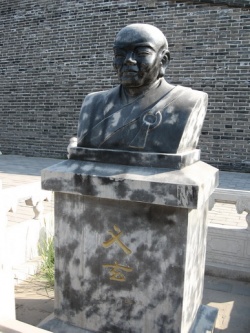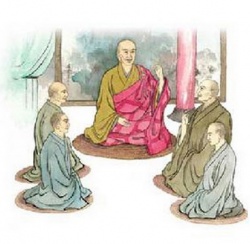Línjì Yìxuán
Línjì Yìxuán (Lin-chi I-hsüan; Japanese: Rinzai Gigen) (?–866) was the founder of the Linji school of Chán Buddhism during Tang Dynasty China. Linji was born into a family named Xing in Caozhou (modern Heze in Shandong), which he left at a young age to study Buddhism in many places. Linji was trained by the Chan master Huángbò Xīyùn (Huang-Po Hsi-Yun) but, according to the Record of Linji, enlightened while discussing Huángbò's teaching during
a conversation with the reclusive monk Dàyú. Linji then returned to Huángbò to continue his training after awakening. In 851, Linji moved to the Linji temple in Hebei, where he took his name, which also became the name for the lineage of his form of Chán Buddhism. The Linji school ultimately became the most successful and widespread of the Five Houses of Chan.
Linji's Teaching Style
Linji's own teaching was greatly inspired by his master's, and was characterized by abrupt, harsh encounters with students, aiming to bring about the moment of enlightenment.
Shouting and Hitting
His methods included shouting and striking, most often using the fly-whisk that was considered a symbol of a Chán master's authority: "The Master (Linji) saw a monk coming and held his fly whisk straight up. The monk made a low bow, whereupon the Master struck him a blow. The Master saw another monk coming and again held his fly whisk straight up. The monk paid no attention, whereupon the Master struck him a blow as well."
Discourses
Linji also taught with lectures and sermons, which were collected by his students into the Línjì-lù (Japanese: Rinzai-roku), the Record of Linji, which also contains stories of his interactions with teachers, contemporaries, and students. His lectures were a
mixture of the conventional and the iconoclastic. He is particularly famous for encouraging his students to free themselves from the influence of masters and doctrinal concepts, in order to be able to better discover their own Buddha-nature. Famed examples of Linji's iconoclasm include the following:
Followers of the Way of Chán), if you want to get the kind of understanding that accords with the Dharma, never be misled by others. Whether you're facing inward or facing outward, whatever you meet up with, just kill it! If you meet a buddha, kill the buddha. If you meet a patriarch, kill the patriarch. If you meet an arhat, kill the arhat. If you meet your parents, kill your parents. If you meet your kinfolk, kill your kinfolk. Then for the first time you will gain emancipation, will not be entangled with things, will pass freely anywhere you wish to go.
Those who have fulfilled the ten stages of bodhisattva practice are no better than hired field hands; those who have attained the enlightenment of the fifty-first and fifty-second stages are prisoners shackled and bound; arhats and pratyekabuddhas are so much filth in the latrine; bodhi and nirvana are hitching posts for donkeys.
Linji's Lineage in Japan
When Chinese Chan was brought to Japan it was called Zen. The Japanese Zen sect known as the Rinzai school is a branch of the lineage Linji founded. The smaller Japanese Obaku school came to Japan in the 17th century as a separate Linji lineage and existed in Japan for many years as a culturally Ming Dynasty Chinese Zen within
Japan. Later the Obaku school semi-merged into the Rinzai lineage, since after Hakuin's revival of Rinzai in the 18th century all Obaku teachers trace their lineage through Hakuin. Today the Rinzai and Obaku schools are closely related. The now-defunct Japanese Fuke school also had close ties to the Rinzai school and claimed affiliation with the Linji lineage.

